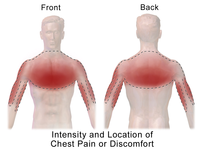
Photo from wikipedia
Introduction Chest pain is one of the most common reasons for presentation to hospital. The objective of the evaluation of patients with chest pain is to identify acute coronary syndrome… Click to show full abstract
Introduction Chest pain is one of the most common reasons for presentation to hospital. The objective of the evaluation of patients with chest pain is to identify acute coronary syndrome (ACS) and other serious cardiovascular conditions. However, diagnostics may not be 100% sensitive or specific, and important diagnoses may be missed during initial admission. No prior national study has evaluated readmission for serious cardiovascular events among the cohort of patients who are discharged with a diagnosis of non-specific chest pain. Methods We conducted an analysis of patients with a primary diagnosis of non-specific chest pain in the Nationwide Readmission Database. We determined the rates, trends and predictors of readmission for serious cardiovascular events (ACS, pulmonary embolism (PE) and aortic dissection (AD)) after an inpatient episode. Multiple logistic regressions were used to identify predictors of readmission for ACS, PE and AD and the cost of the readmissions were determined. Results A total of 1,172,430 patients had an index diagnosis of non-specific chest pain between 2010 and 2014. Readmission for ACS, PE and AD were 2.4%, 0.4% and 0.06%, respectively within 6 months of discharge. Variables associated with ACS readmissions were diabetes (OR 1.49 95%CI 1.17–1.32), coronary artery disease (OR 2.29 95%CI 2.15–2.44), previous percutaneous coronary intervention (OR 1.65 95%CI 1.56–1.75), previous coronary artery bypass graft (OR 1.52 95%CI 1.43–1.61) and discharge against medical advice (OR 1.94 95%CI 1.78–2.12). Female patients (OR 0.82 95%CI 0.78–0.86) and patients in whom a coronary angiogram was undertaken (OR 0.48 95%CI 0.45–0.52) were less likely to have a readmission for ACS. Predictors of PE readmission were pulmonary circulatory disorder (OR 2.20 95%CI 1.09–4.43), anaemia (OR 1.62 95%CI 1.40–1.86) and cancer (OR 4.15 95%CI 3.43–5.02). Predictors of AD readmissions were peripheral vascular disease (OR 8.63 95%CI 5.47–13.60) and renal failure (OR 2.08 95%CI 1.34–3.24). There were approximately 5,586 ACS readmissions, 950 pulmonary embolism readmissions and 113 aortic dissection readmissions in our study cohort and the estimated financial impact was $99 million, $17 million and $3.5 million dollars of healthcare expenditure for ACS, PE and AD, respectively. Conclusion Readmissions for serious cardiovascular disease following admission for non-specific chest pain are not uncommon and its financial burden can be significant accounting for approximately $120 million dollars of healthcare expenditure in the United States between 2010 and 2014. Clinicians should be careful to appropriately investigate, risk stratify and tailor services to better manage patients with non-specific chest pain. Conflict of Interest None
Journal Title: Heart
Year Published: 2019
Link to full text (if available)
Share on Social Media: Sign Up to like & get
recommendations!